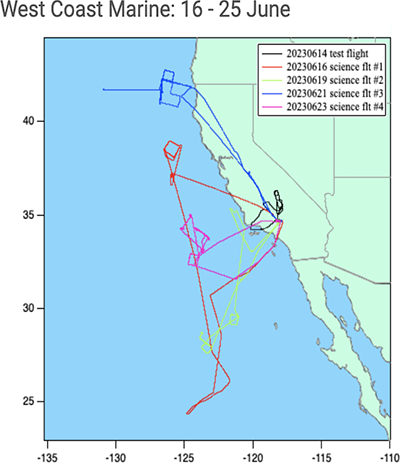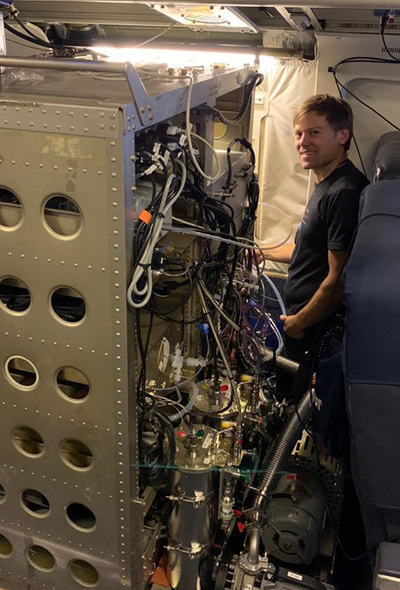A .gov website belongs to an official government organization in the United States.
A lock () or https:// means you've safely connected to the .gov website. Share sensitive information only on official, secure websites.
29 June 2023
adapted from the story by NOAA Communications

Those fluffy, white clouds over the ocean don't just make for pretty pictures – they also play a big role in moderating global climate by controlling how much sunlight reaches the sea surface below them.
While the shade offered by clouds on a hot sunny day can be obvious, quantifying the actual climate impact in terms of solar energy remains a challenging task. This is because the volume, thickness, and lifetime of marine clouds can change rapidly, and the processes that govern how and where clouds form and how gases and aerosols in the air interact with cloud droplets are highly complex. In a marine environment, many of those gases and aerosols in the air come from the ocean itself.
This week, researchers from NOAA's Chemical Sciences Laboratory and the Cooperative Institute for Research in Environmental Sciences (CIRES) at the University of Colorado Boulder, joined by other university collaborators, are wrapping up a series of research flights over the Pacific Ocean in the world's largest flying atmospheric research laboratory to better understand the complex relationship between the ocean, aerosols, clouds, and climate.


The flights are one component of a sprawling, coast-to-coast air quality research campaign led by CSL happening this summer called AEROMMA (Atmospheric Emissions and Reactions Observed from Megacities to Marine Areas). The project is using NASA's DC-8 research aircraft, loaded with 30 instruments, specially designed to measure an array of important trace gases, including ozone, volatile organic compounds, and sulfur compounds, as well as aerosol properties, such as size distribution, chemical composition, and reflectivity.
Their target: sulfur gases released by plankton and wave action that form tiny aerosol particles, which in turn seed the growth of marine clouds that shade the ocean.
"The world's oceans are the largest natural source of the sulfur compounds to the atmosphere," explained CSL scientist Drew Rollins, the principal investigator leading the marine science portion of AEROMMA. "This is primarily in the form of dimethyl sulfide (DMS), which reacts in the air to form oxidized sulfur products that in turn will create sulfate aerosols."
Although emitted to the atmosphere as a gas, sulfur compounds like DMS can be transformed into particles through a process known as new particle formation. Previous research out of CSL provided strong evidence that the upper troposphere over the tropical oceans is the most important region of new sulfate particle formation globally.
When mixed down in the atmosphere near the ocean surface, sulfate aerosols can grow in size to form larger particles that become cloud droplets with sufficient water vapor. If existing clouds are already present, sulfate aerosols can act to brighten those clouds, making them more reflective to sunlight–a phenomenon known as the aerosol indirect effect.
"These indirect effects of marine aerosols on clouds remain the climate contributor with the largest uncertainty in current IPCC reports," said Rollins. "Getting a better understanding of sulfur chemistry and aerosol processes and how they affect marine clouds is vital for improving our climate models."
Once thought to be fully understood, the mechanics of the marine sulfur cycle are now being reassessed following the 2017 discovery by CSL scientists of a previously unobserved sulfur molecule in the marine atmosphere during a previous campaign on-board the NASA DC-8, the Atmospheric Tomography Mission (ATom). Scientists realized the new chemical, which they named hydroperoxymethyl thioformate or HPMTF for short, offered an alternative path for creating the sulfate aerosols that are so important to cloud formation.
Another ocean-emitted sulfur compound that is also a target of the AEROMMA project is carbonyl sulfide, which is an important natural source of sulfate aerosols to the stratosphere. Sulfate aerosols can scatter or reflect sunlight, a property that has made them a central focus for stratospheric aerosol injection proposals as a means to mitigate climate change.
"The big picture on these marine flights is we're seeking to understand and quantify details of the important natural marine emissions and how they evolve in the atmosphere in ways that link these gases to climate impacts," said Rolllins.
Learn more about the AEROMMA mission and coordinated research efforts.